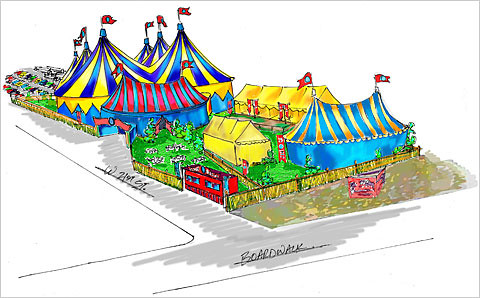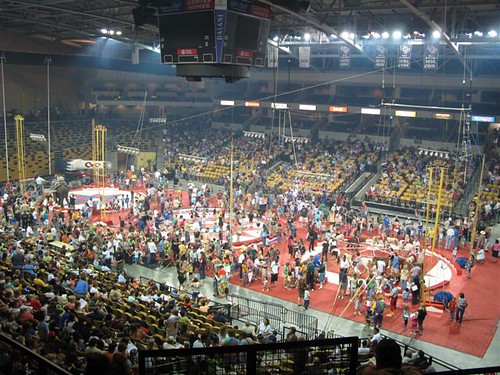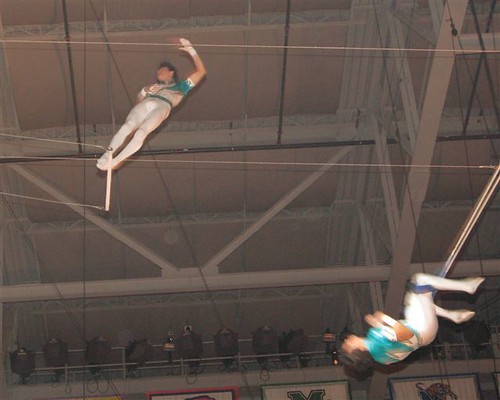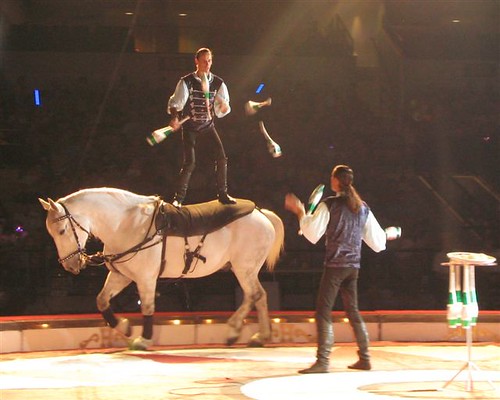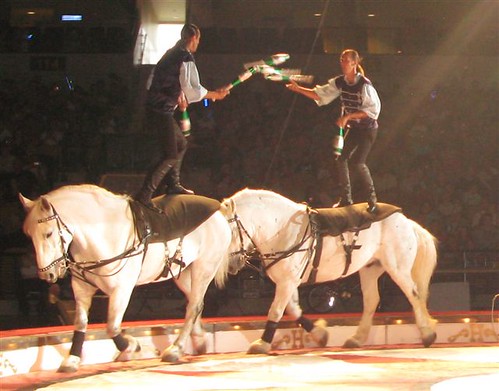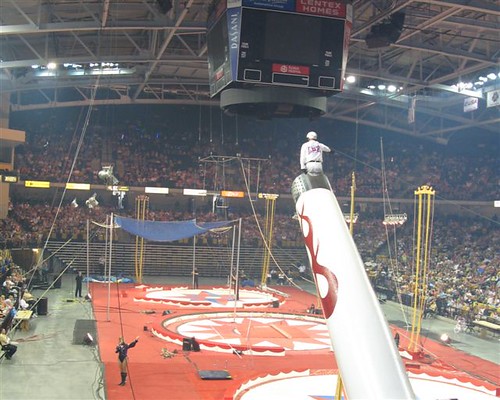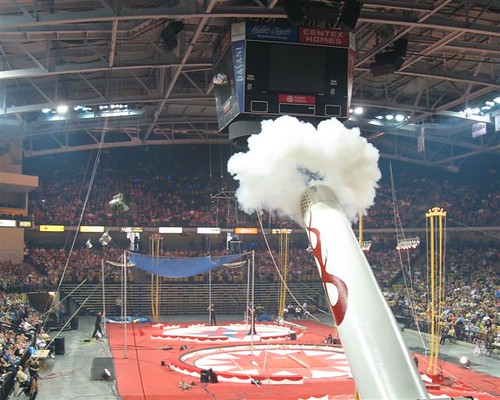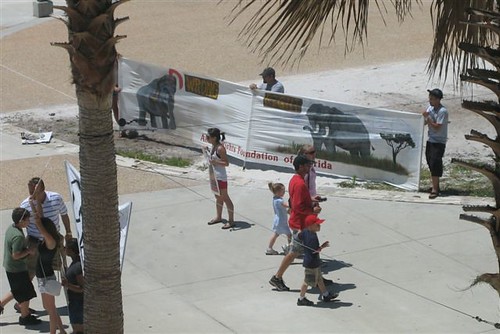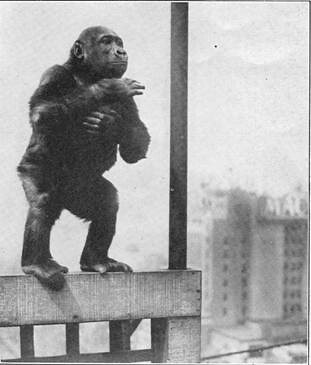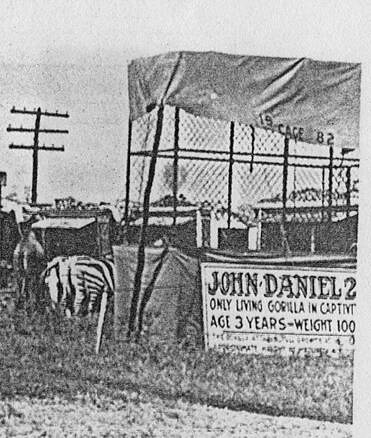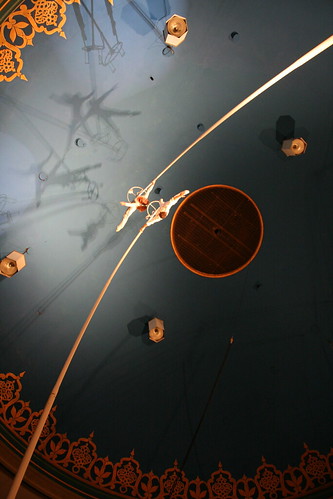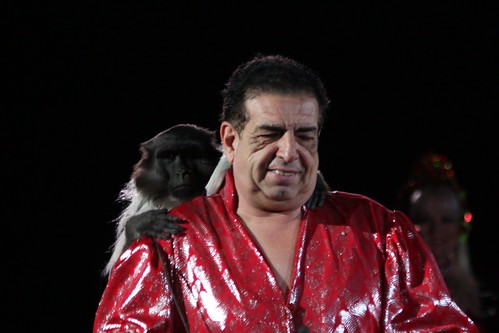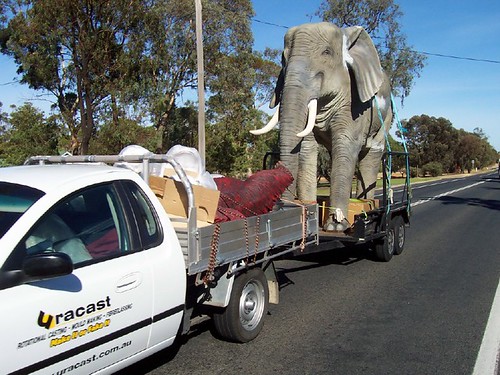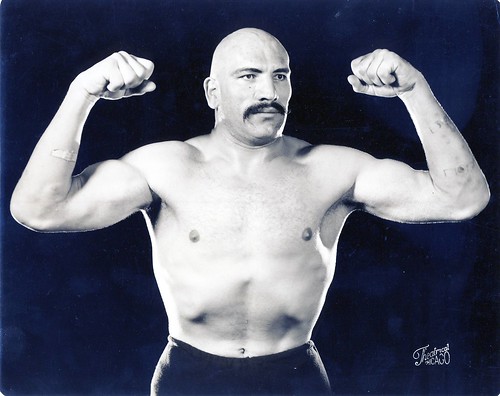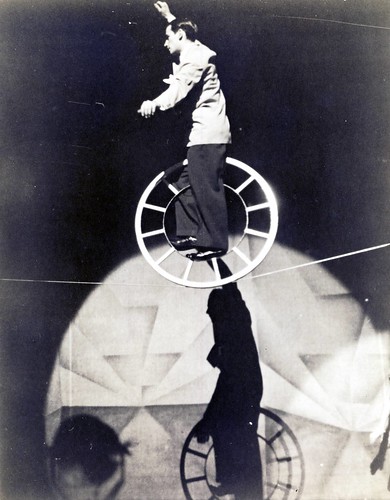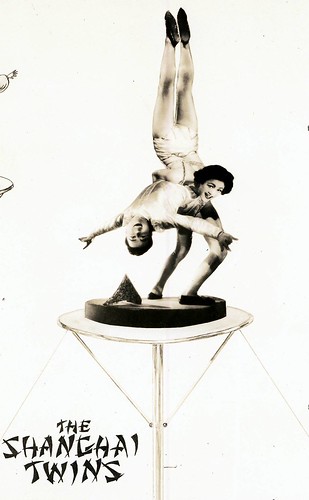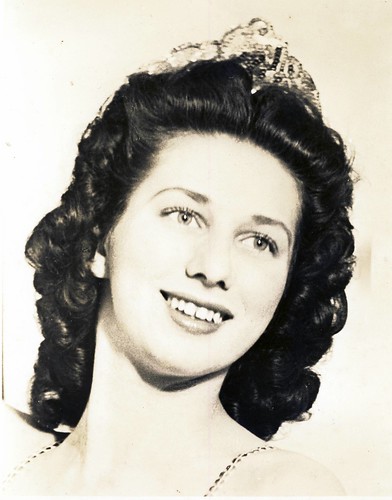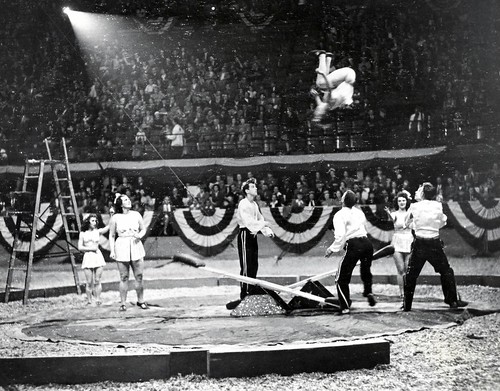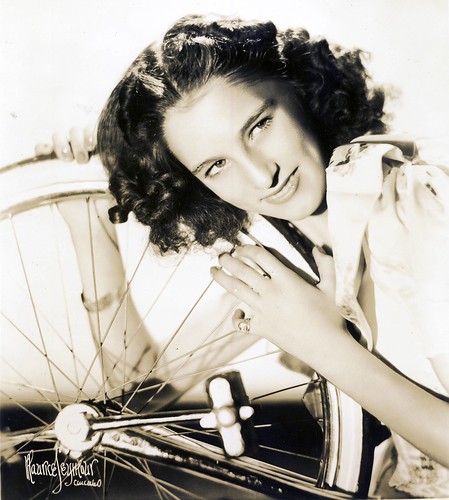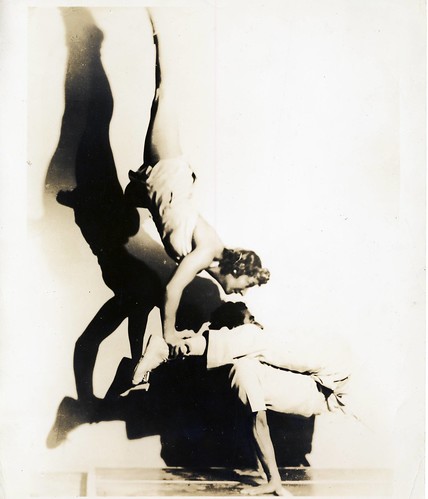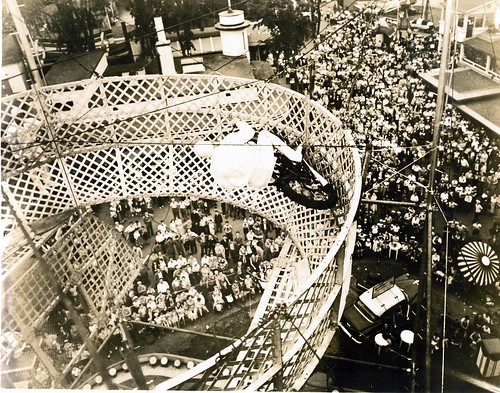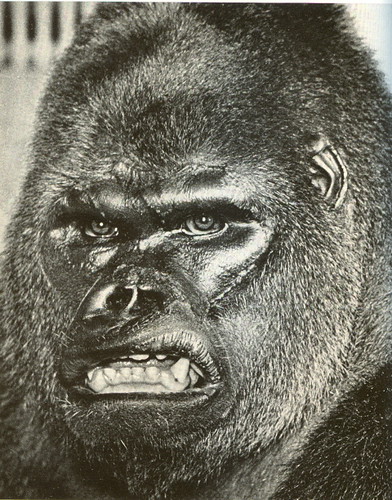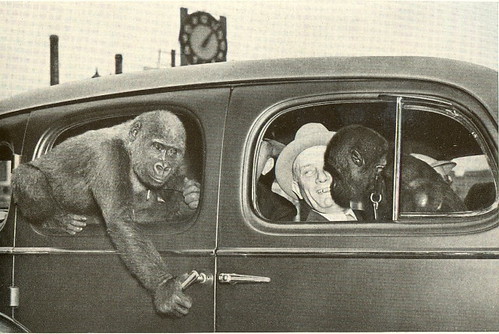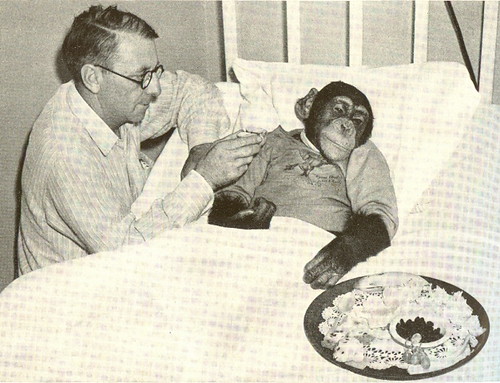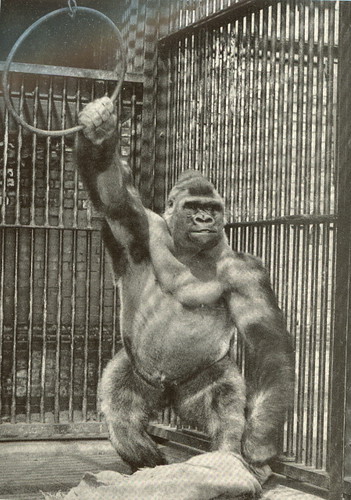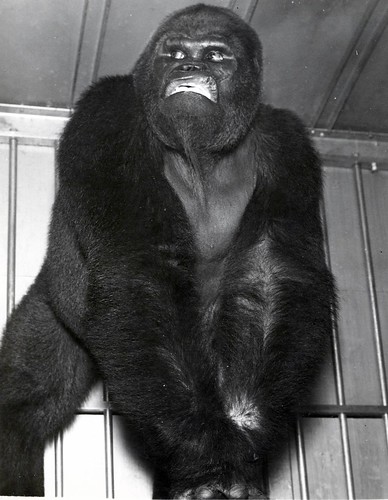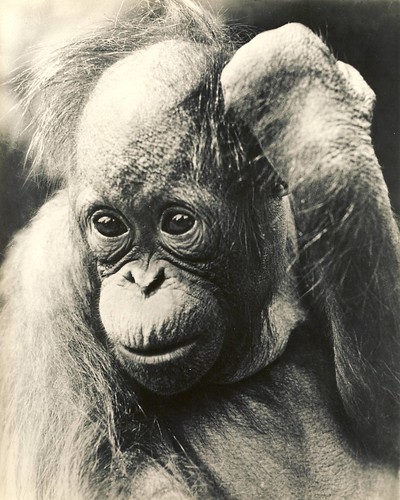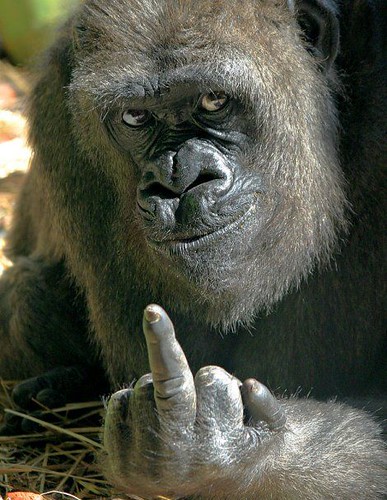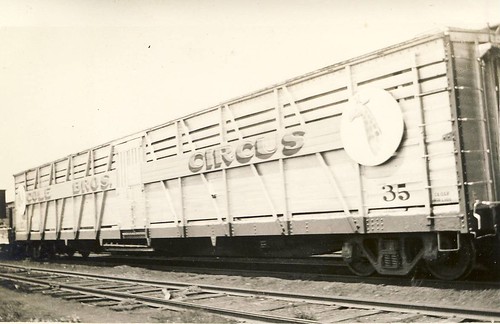An artist's conception in the New York Times of the new tented circus that Ringling Bros. and Barnum & Bailey Circus will bring to Coney Island June 18, entitled "Boom-a-Ring". |
Thursday, April 30, 2009
From Don Covington
Posted by
Buckles
at
4/30/2009 11:26:00 AM
10
comments
![]()
Hanneford in Orlando #1 (From Jim Cole)
Hanneford Circus, Orlando, FL, Apl. 26, 2009 during intermission. One of 4 Hannerford units working that weekend. |
Posted by
Buckles
at
4/30/2009 06:13:00 AM
3
comments
![]()
Hanneford in Orlando #2
Flying Tuniziani from Venezuela |
Posted by
Buckles
at
4/30/2009 06:10:00 AM
0
comments
![]()
Hanneford in Orlando #3
Robbie & David Donnert #1 |
Posted by
Buckles
at
4/30/2009 06:09:00 AM
0
comments
![]()
Hanneford in Orlando #4
Robbie & David Donnert #2 |
Posted by
Buckles
at
4/30/2009 06:07:00 AM
0
comments
![]()
Hanneford in Orlando #5
David Donnert & Chief Bear Paw 4 ...The horse and act was originally Gaylord Maynard's. |
Posted by
Buckles
at
4/30/2009 06:04:00 AM
1 comments
![]()
Hanneford in Orlando #8
Smith Cannon #2, notice how close he is to the score-board. |
Posted by
Buckles
at
4/30/2009 05:56:00 AM
1 comments
![]()
Hanneford in Orlando #9
Protesters in front of the arena, ignored by most circus patrons. |
Posted by
Buckles
at
4/30/2009 05:54:00 AM
0
comments
![]()
Wednesday, April 29, 2009
Any elephants available?
Hi Buckles, I know that your last email to me stated that you, as well as your elephants, were retired. I hope that you are enjoying it, as I too some day hope to find myself much less busy with work related items, and much more busy in cleaning fresh caught trout off of my fly rod. Till such time, I've had a request for 1-2 elephants for a one day engagement in New Hampshire on July 4th. Noon to 5pm. Elephant avail for some photos, maybe some rides, and if the elephant is presented in some type of performance, that would be nice but not mandatory. If you have any leads that you can supply, or would forward this note, that would be appreciated. Thank you for taking the time to read and review this email. Best always! Ron Severini Executive Producer CASTLE TALENT, Inc. P.O. Box 767 Windermere, FL 34786 (407) 909-9650 WEBSITE: www.castletalent.com |
Posted by
Buckles
at
4/29/2009 05:37:00 PM
6
comments
![]()
John Daniel #1 (From Richard Reynolds)
|
Posted by
Buckles
at
4/29/2009 05:59:00 AM
2
comments
![]()
John Daniel II #1 (From Richard Reynolds)
This is John Daniel II, the second of Miss Cunningham's gorillas to join RBBB. He was on the 1924 show and made the full tour. However unlike John the first, the lady retained ownership and the show had John II on a lease arrangement. He was originally called Sultan or John Sultan. He had originated in Gabon and was acquired in 1923 by Miss Cunningham of London. |
Posted by
Buckles
at
4/29/2009 05:57:00 AM
0
comments
![]()
John Daniel II #2
|
Posted by
Buckles
at
4/29/2009 05:55:00 AM
0
comments
![]()
John Daniel II #3
Here we see John Daniel 2nd peering out the window of the sleeper compartment he shared with Miss Cunningham on the 4th section of the circus train. The picture is none too clear but you can make him out. Reports said he loved to ride the train looking out the window. |
Posted by
Buckles
at
4/29/2009 05:53:00 AM
0
comments
![]()
John Daniel II #4
|
Posted by
Buckles
at
4/29/2009 05:52:00 AM
3
comments
![]()
John Daniel II #5
John Daniel II spent a lot of time in the backyard. Can anyone identify this clown? There is at least one more photo of the two - -likely the work of photographer Harry Atwell who took a lot of pictures when the show played Chicago. In 1924 RBBB was at Chi-town's Grant Park from August 15 through 24 - - a 10 day stand. |
Posted by
Buckles
at
4/29/2009 05:50:00 AM
0
comments
![]()
John Daniel II #6
Here we see the John Daniel II disporting himself in the backyard. Providing him with such wide activity was likely good for his health. That coupled with Miss Cunningham's constant companionship allowed him to complete the entire 1924 tour in good health. |
Posted by
Buckles
at
4/29/2009 05:49:00 AM
0
comments
![]()
John Daniel II #7
|
Posted by
Buckles
at
4/29/2009 05:44:00 AM
1 comments
![]()
Tuesday, April 28, 2009
FSU floats the idea of closing the Ringling Museum!
The state Legislature and Florida State University, which respectively fund and own the museum, have entered into a game of brinkmanship over the fate of the internationally famous Sarasota institution. It's the largest university museum complex in the United States, with a world-class collection of Old Master paintings in its art museum. In addition, it includes Ca d'Zan, the historic home of its founder, John Ringling; the restored 18th century Asolo Theater; an education center, library and art conservation lab; and a Circus Museum considered one of the finest in the United States, all on 66 acres of waterfront. It is the only state art museum in Florida. |
Posted by
Buckles
at
4/28/2009 05:36:00 PM
0
comments
![]()
Flower Girl
This is Grand Daughter Kay at her Aunt Tammy's wedding in Birmingham, Alabama last weekend. |
Posted by
Buckles
at
4/28/2009 06:14:00 AM
1 comments
![]()
Flower Girl and Ring Bearer
Yesterday on her return I asked who this was and she answered, "My Boy Friend!" |
Posted by
Buckles
at
4/28/2009 06:12:00 AM
0
comments
![]()
More from Altoona #1 (From Paul Gutheil)
Mike & Tina Winn let me lie down flat on my back to take a few shots straight up |
Posted by
Buckles
at
4/28/2009 06:01:00 AM
2
comments
![]()
More from Altoona #2
Davide Zoppe, poor guy's always got a monkey on his back. |
Posted by
Buckles
at
4/28/2009 05:59:00 AM
0
comments
![]()
From Robert Perry
|
Posted by
Buckles
at
4/28/2009 05:54:00 AM
0
comments
![]()
From Joe Giordano
Cats are so dramatic.......... |
Posted by
Buckles
at
4/28/2009 05:50:00 AM
0
comments
![]()
Monday, April 27, 2009
From Kari Johnson
Thanks to everyone who contacted their legislators regarding HR 669!!!! Effort to Ban Exotic Pets 'Effectively Dead' Posted: Friday, April 24, 2009, By Benjamin Weiner Opponents of House Resolution 669, known as the Nonnative Wildlife Invasion Prevention Act, proclaimed the bill "effectively dead" after a Congressional subcommittee hearing April 23 in Washington, D.C. The legislation could have halted trade in thousands of nonnative animal species in the U.S., including most birds, reptiles, fish and several mammals-hamsters, gerbils, guinea pigs and ferrets-commonly kept as pets. Pet owners and pet industry players throughout the country have been contacting their representatives in grass-roots opposition to the bill. The hearing was held by the Subcommittee on Insular Affairs, Oceans and Wildlife, chaired by Rep. Madeleine Bordallo, D-Guam, who wrote the bill. The hearing record is being held open for 10 days for responses and for the panel to decide whether to proceed with the bill. But Andrew Wyatt, president of the United States Association of Reptile Keepers, called the hearing a "smashing success." "H.R. 669 is effectively dead," Wyatt said. "Two weeks leading up to the hearing, USARK mounted a grass-roots campaign of letter writing and phone calls," he said. "We swamped Capitol Hill with almost 50,000 letters that were delivered to subcommittee members." Wyatt added that on top of that, thousands of phone calls were made and e-mails and letters sent to subcommittee members. Marshall Meyers, CEO and general counsel for the Pet Industry Joint Advisory Council, testified before the panel as a representative of pet owners and the pet industry. "We support the development of a strategic, risk-based process to prevent the introduction of invasive species into the United States," Meyers said in written testimony. Invasive species are nonnative species that can be harmful if introduced into the environment. However, he continued, the current draft of the bill "does not adequately take socio-economic issues and risk management options into account" and would "require funds and staffing not currently available, nor likely to be available, to the U.S. Fish and Wildlife Service." Meyers said PIJAC is willing to work with the subcommittee to craft more realistic legislation that serves the public and affected industries alike. "We recognize the bill is by no means perfect and that changes will be needed to address various concerns before any legislation moves forward," said Rep. Bordallo, the chairwoman. "As it stands, PIJAC still has issues with points of this bill's impracticality or lack of clarity," Meyers said. "During the past few weeks I have received thousands of calls, e-mails and letters written by constituents in strong opposition to this bill," subcommittee member Rep. Henry E. Brown, R-S.C., said during the hearing. Later, Wyatt quoted Harry Burroughs of the subcommittee staff as telling him, "I haven't seen a letter writing campaign like this in 30 years! You should be proud of yourselves." Rep. Eni F.H. Faleomavaega of American Samoa, a bill co-sponsor, congratulated Meyers, PIJAC and the pet industry for the tremendous grassroots response that has been generated, noting that it is important to have input from constituents. Wyatt added that Faleomavaega said that the letters and phone calls hit them like a "buzz saw." "We're so proud of all the people out there who sent letters and e-mails and made phone calls," he said. No further action is necessary from pet owners and the pet industry, Wyatt said. PIJAC and USARK will continue to monitor the bill. |
Posted by
Buckles
at
4/27/2009 05:18:00 PM
0
comments
![]()
Gee Gee's albums #10
I recall reading back in the 1950's that JRN was bringing over an act from Europe similar to this when the show was still under canvas. Buckles |
Posted by
Buckles
at
4/27/2009 06:32:00 AM
7
comments
![]()
Sunday, April 26, 2009
GORILLA #1 (From Eric Beheim)
The August 1940 issue of NATIONAL GEOGRAPHIC has an article about great apes by William Mann, Director of the National Zoo in Washington, D.C. |
Posted by
Buckles
at
4/26/2009 06:11:00 AM
3
comments
![]()
GORILLA #2
There was also a photo of Mrs. E. Kenneth Hoyt with her gorilla M’Toto which, of course, later ended up with Gargantua on the Ringling show. |
Posted by
Buckles
at
4/26/2009 06:09:00 AM
0
comments
![]()
GORILLA #3
The article used an AP news photo of George P. Vierheller from the St. Louis Zoo with two little gorillas, a male and a female. (I would image that this was a staged photo op, since these two youngsters could probably have torn up the inside of that car in short order.) Richard Reynolds can probably identify these two and tell us more about their histories. |
Posted by
Buckles
at
4/26/2009 06:08:00 AM
5
comments
![]()
GORILLA #4
There was another news photos showing a young chimp that was treated for double pneumonia at Victoria Hospital in Miami by being put in an oxygen-tent. The chimp’s owner was identified as Edward Strassburg. |
Posted by
Buckles
at
4/26/2009 06:07:00 AM
0
comments
![]()
GORILLA #5
The article also had this great photo of the Philadelphia Zoo’s gorilla Massa, who was only 10 years old at the time it was taken and still growing. (Once again, Richard Reynolds can probably give us Massa’s life story.) |
Posted by
Buckles
at
4/26/2009 06:06:00 AM
2
comments
![]()
From Richard Reynolds
JOHN DANIEL - - Since 1918 this gorilla had been a London pet of an animal loving British lady, Miss Alyce (or Alyse) Cunningham. |
Posted by
Buckles
at
4/26/2009 06:01:00 AM
0
comments
![]()
Gargantua the Great #1 (From Buckles)
Hand written on the back: |
Posted by
Buckles
at
4/26/2009 06:00:00 AM
0
comments
![]()
Gargantua the Great #5
"A rare picture of Gargantua taken when he was at my exact age, 74! Buckles |
Posted by
Buckles
at
4/26/2009 05:53:00 AM
1 comments
![]()
Saturday, April 25, 2009
From Richard Flint
The recent comments made under Thursday’s posting of the NY Times obituary for Tim Holst made me think an apparent hallmark of Ringling talent scouts is an interest in circus history. I met Tim Holst when he was a young ringmaster interested in acquiring some of my duplicate RBBB programs and books. When he became a globetrotter, Tim and I would talk of various circus books published around the world that we both collected. Later, his collecting interests turned to circus stamps but he always relished telling me of how he was given some material by a descendant of James. L. Hutchinson of the Barnum & London partnership. |
Posted by
Buckles
at
4/25/2009 06:10:00 AM
0
comments
![]()





